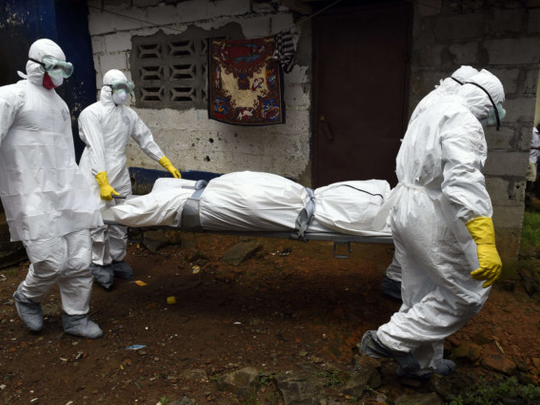
West Africa’s Ebola epidemic, which has already claimed about 2,000 victims, could get a lot worse before it gets better — particularly in the (apparently unlikely) event that the virus evolves to spread from person to person through the air. It could end up in major cities in Europe or the US, in India or China.
Will it? The truth is that nobody knows.
Back in 1976, the first outbreak of Ebola in what was then Zaire caused only 318 illnesses and 280 deaths. Since then, a lot has changed to make the virus more mobile. West Africa is much more densely populated and those people move around more. A global air network links Lagos, Monrovia and other affected cities to other major population centres in Africa and around the world. The latest outbreak, which originated in Guinea, Sierra Leone and Liberia, has now spread to Senegal and Nigeria. The World Health Organisation projects roughly 12,000 infected by mid-October, if the epidemic keeps growing as it has so far. Other simulations suggest it could be worse, with more than one million infected by early next year.
When something scary happens we want reassuring answers. We set experts to analysing what will likely happen. But if we are realistic, we should not expect certainty. Modern modelling of epidemics combines computers with lots of data on human movements and takes into account the fine details of actual transportation networks. Scientists run simulations, starting an epidemic off in some location and following its spread. The resulting projections are more accurate than ever, but an epidemic, like the weather, is highly uncertain for good reasons. Just one infected person arriving in a dense city far away can have huge repercussions. The fate of an epidemic also depends on how people and health authorities react, requiring modellers to run different scenarios of the speed and reach of the human response. The result is a vast range of possible outcomes, reflecting the truth that the future is uncertain and often depends crucially on what we do tomorrow and next week. An epidemic is far easier to slow in its early stages, when the boundary between the infected and uninfected is relatively small, than it is after it breaks out more broadly.
In this regard, it is good news that the epidemic has not yet reached other continents and that African nations are carefully controlling traffic flows from the hard-hit region. Models run by researchers at Columbia University show hints that health measures are beginning to slow the epidemic, at least in Guinea and Liberia. Another consortium of modellers is maintaining a live research paper with continuous updates.
Public health authorities in industrialised nations have considerable expertise in preventing diseases from crossing international borders. The challenge is that someone infected with Ebola can carry the virus for as long as three weeks without showing any symptom. It thus will not be surprising if cases start showing up elsewhere around the world. The most important time for response is now, before the resources required to contain the disease become many times greater. Effective response to an epidemic is as much about information as it is about medicine. When the South Asian Respiratory Syndrome (Sars) virus created a global panic back in 2002 and 2003, it underscored the need for greater international sharing of information. Since then, cooperation among Asian nations and the West has improved greatly, making rapid response possible. Africa has not made as much progress, despite the continent’s role as a potential epicentre for a host of viruses that could spread from animals to humans.
Ebola is not solely a biological problem. The ultimate threat it presents depends to a great extent on how humans have shaped the global environment. In Africa, the loss of natural habitat for species such as the fruit bat has greatly increased interactions among people and the natural hosts of viruses such as Ebola. Globally, advances in transportation networks have made it easier for diseases to spread farther and more quickly than ever before. Maybe the epidemic really is slowing. But every time it passes from one person to another it has another chance to mutate into something more infectious. One prominent scientist I met, who has been developing epidemic models for more than a decade and experienced the Sars and H1N1 epidemics firsthand, told me that this is the first time he has been really scared, “because we just don’t know what could happen”.
— Washington Post
Mark Buchanan, a physicist and Bloomberg View columnist, is the author of the book Forecast: What Physics, Meteorology and the Natural Sciences Can Teach Us About Economics.










